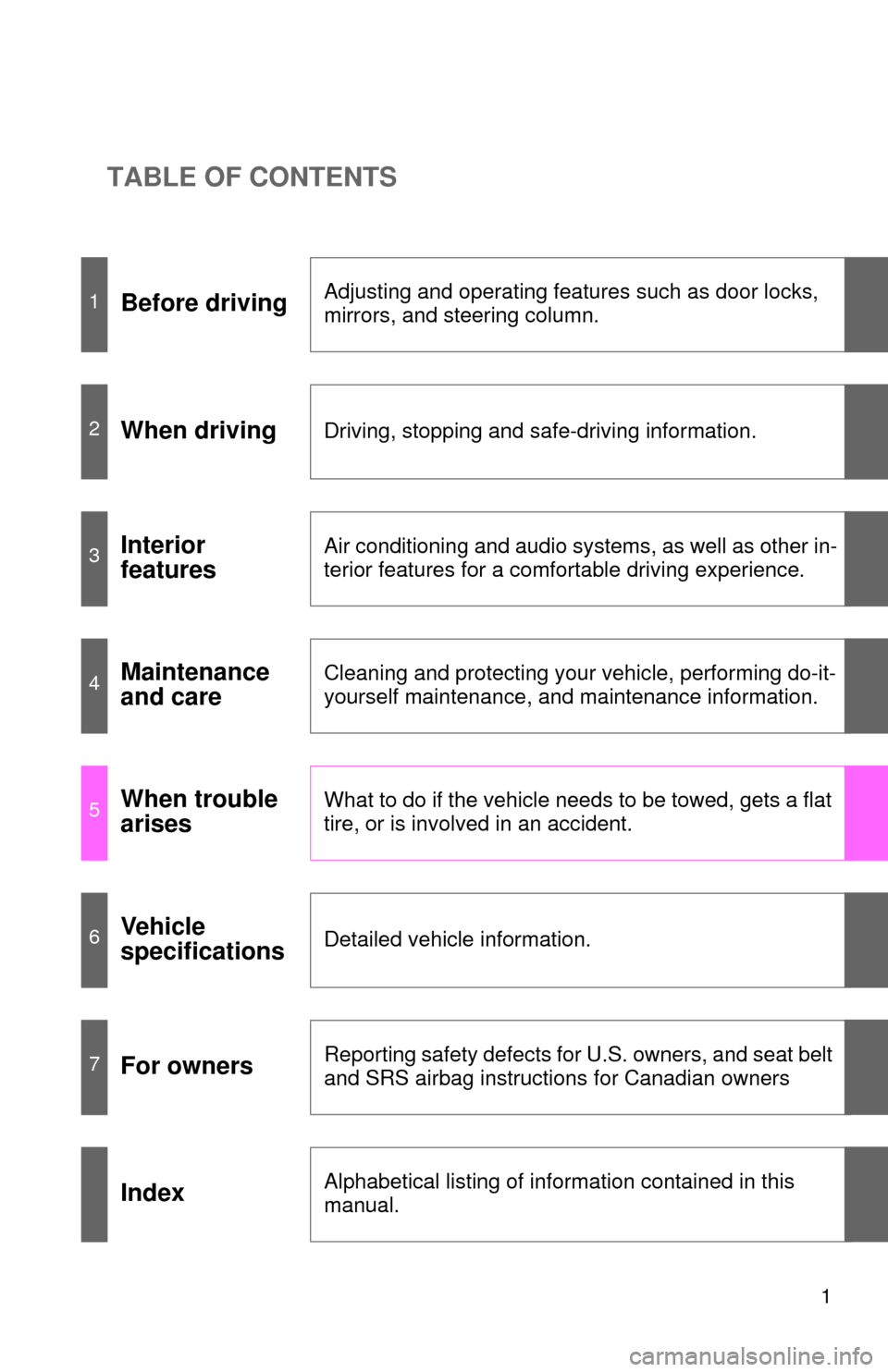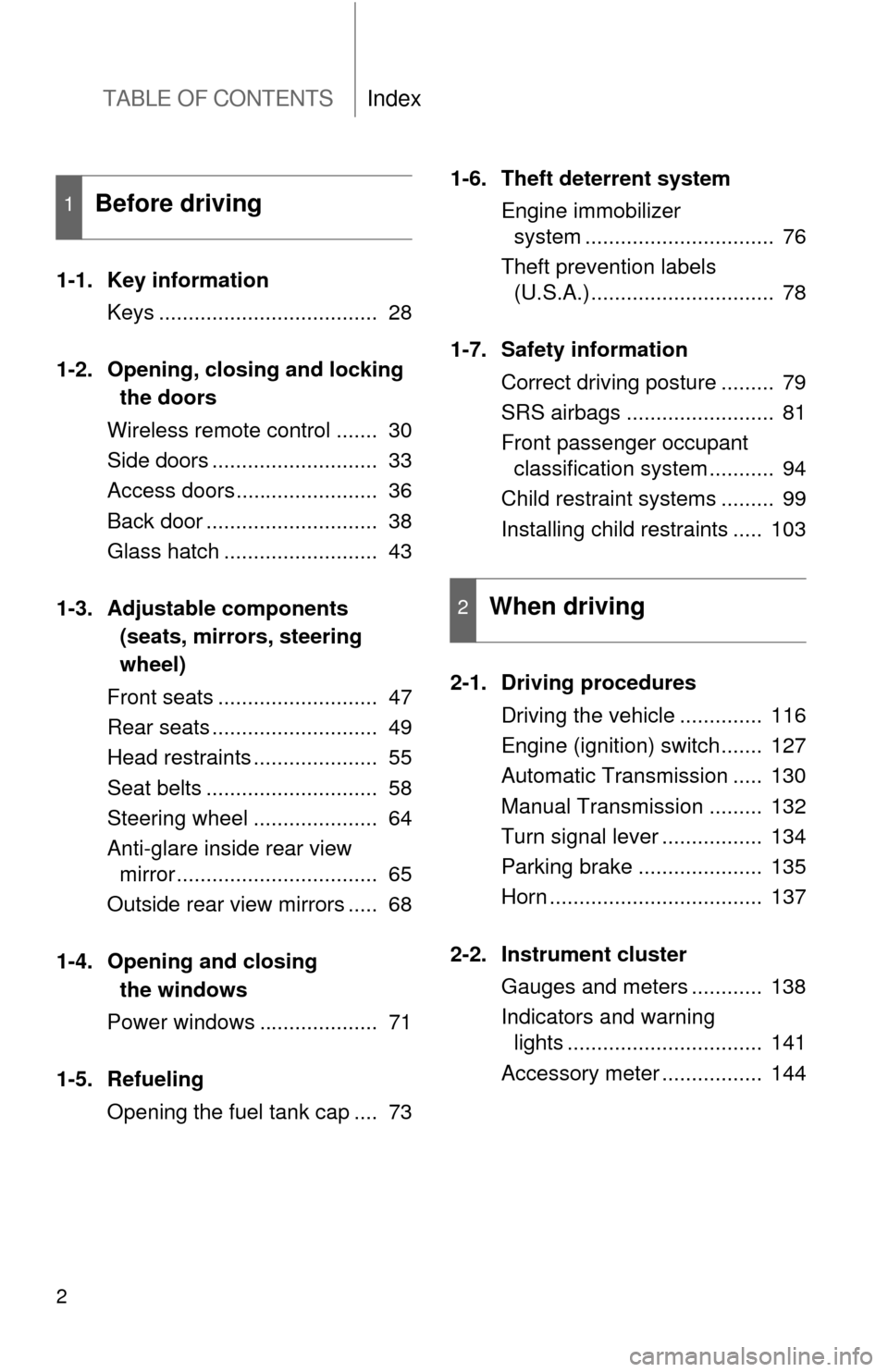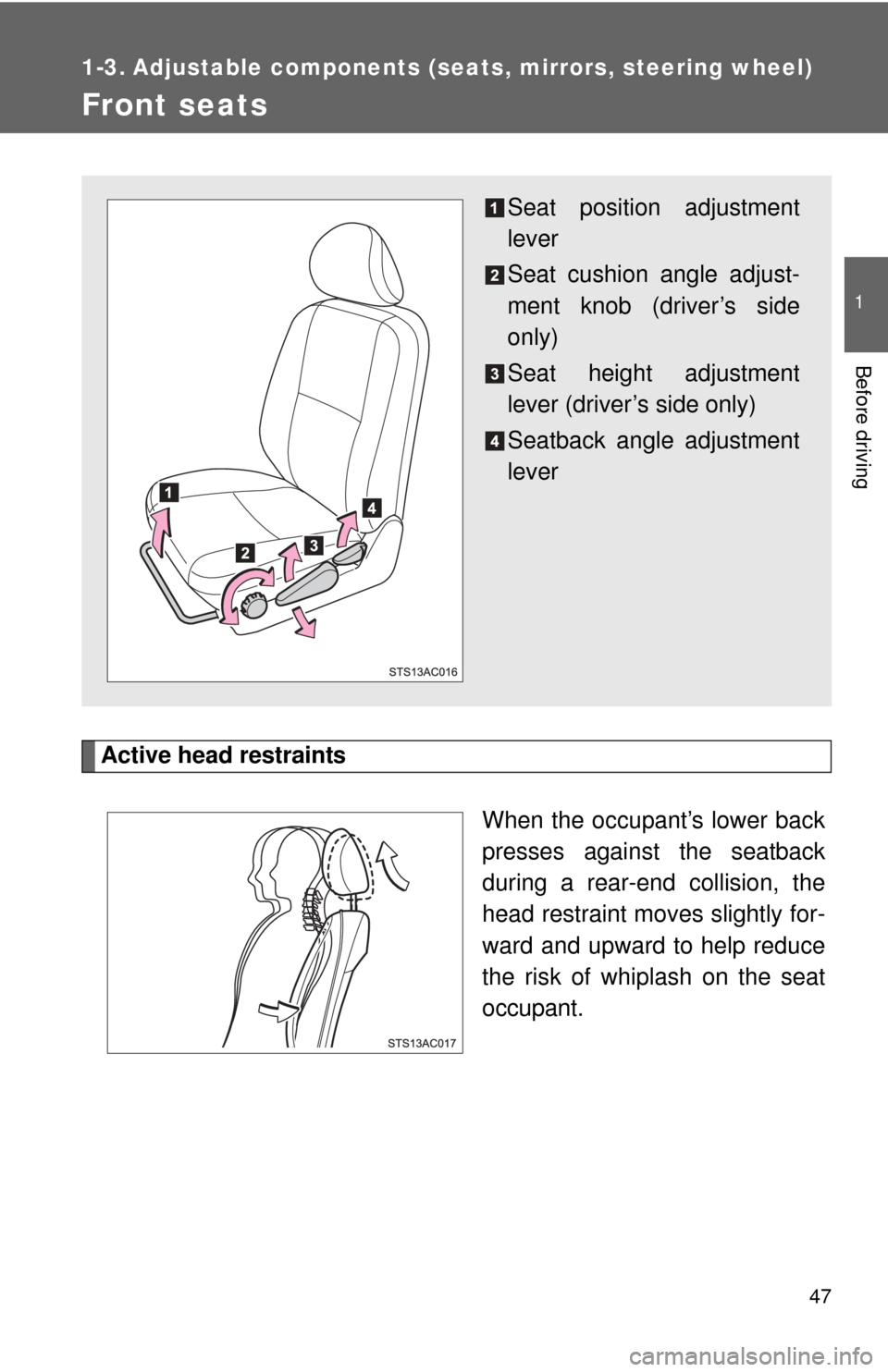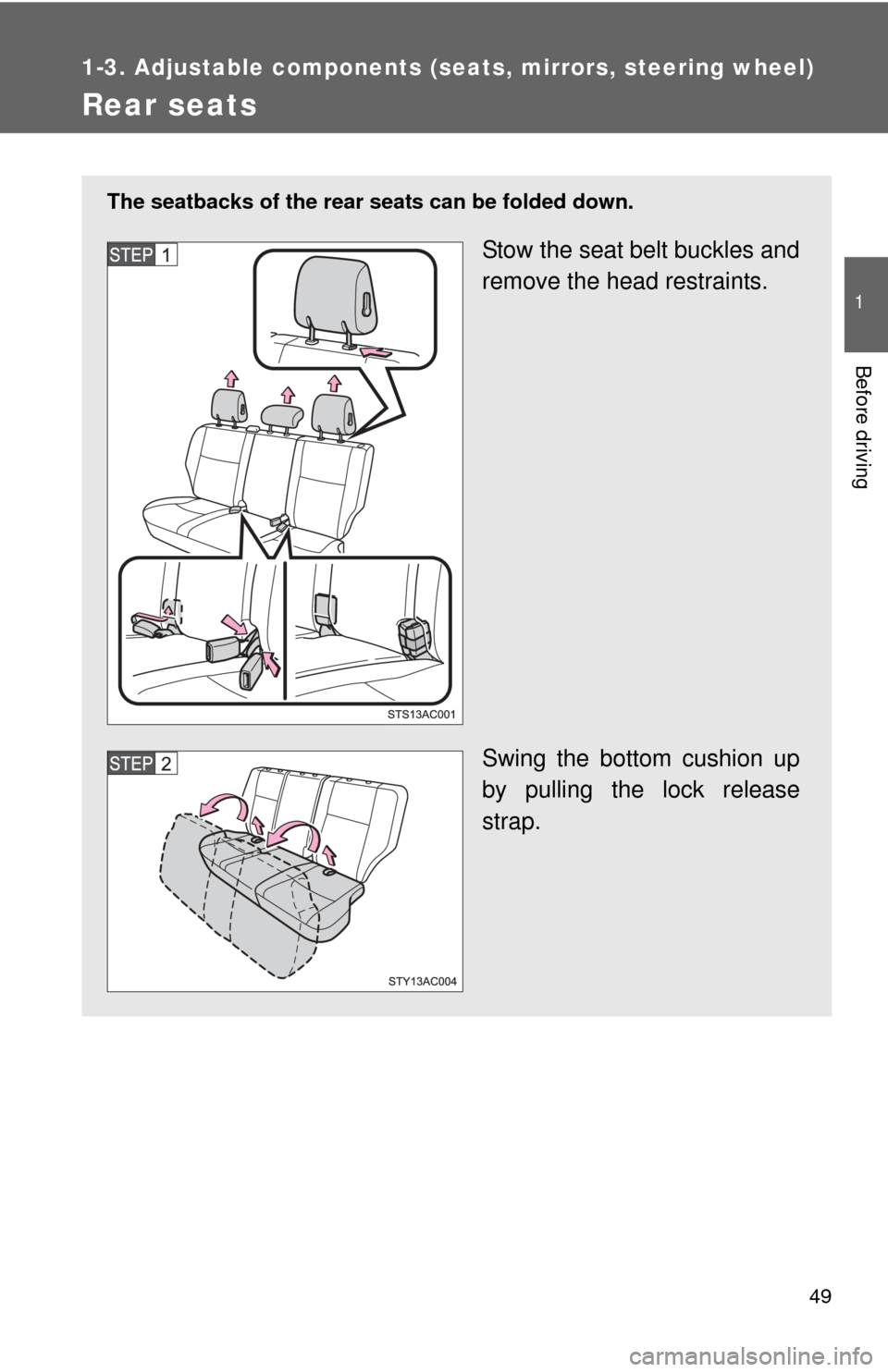mirror TOYOTA FJ CRUISER 2012 1.G Owners Manual
[x] Cancel search | Manufacturer: TOYOTA, Model Year: 2012, Model line: FJ CRUISER, Model: TOYOTA FJ CRUISER 2012 1.GPages: 540, PDF Size: 10.32 MB
Page 1 of 540

TABLE OF CONTENTS
1
1Before drivingAdjusting and operating features such as door locks,
mirrors, and steering column.
2When drivingDriving, stopping and safe-driving information.
3Interior
featuresAir conditioning and audio systems, as well as other in-
terior features for a comfortable driving experience.
4Maintenance
and careCleaning and protecting your vehicle, performing do-it-
yourself maintenance, and maintenance information.
5When trouble
arisesWhat to do if the vehicle needs to be towed, gets a flat
tire, or is involved in an accident.
6Vehicle
specificationsDetailed vehicle information.
7For ownersReporting safety defects for U.S. owners, and seat belt
and SRS airbag instructions for Canadian owners
IndexAlphabetical listing of information contained in this
manual.
Page 2 of 540

TABLE OF CONTENTSIndex
2
1-1. Key informationKeys ..................................... 28
1-2. Opening, closing and locking the doors
Wireless remote control ....... 30
Side doors ............................ 33
Access doors........................ 36
Back door ............................. 38
Glass hatch .......................... 43
1-3. Adjustable components (seats, mirrors, steering
wheel)
Front seats ........................... 47
Rear seats ............................ 49
Head restraints ..................... 55
Seat belts ............................. 58
Steering wheel ..................... 64
Anti-glare inside rear view mirror .................................. 65
Outside rear view mirrors ..... 68
1-4. Opening and closing the windows
Power windows .................... 71
1-5. Refueling Opening the fuel tank cap .... 73 1-6. Theft deterrent system
Engine immobilizer system ................................ 76
Theft prevention labels (U.S.A.)............................... 78
1-7. Safety information Correct driving posture ......... 79
SRS airbags ......................... 81
Front passenger occupant classification system ........... 94
Child restraint systems ......... 99
Installing child restraints ..... 103
2-1. Driving procedures Driving the vehicle .............. 116
Engine (ignition) switch....... 127
Automatic Transmission ..... 130
Manual Transmission ......... 132
Turn signal lever ................. 134
Parking brake ..................... 135
Horn .................................... 137
2-2. Instrument cluster Gauges and meters ............ 138
Indicators and warning lights ................................. 141
Accessory meter ................. 144
1Before driving
2When driving
Page 4 of 540

TABLE OF CONTENTSIndex
4
3-4. Using the hands-free phonesystem (for cellula r phone)
Hands-free phone system (for cellular phone) ........... 293
Using the hands-free phone system
(for cellular phone) ........... 297
Making a phone call ........... 306
Setting a cellular phone...... 311
Security and system setup ................................ 317
Using the phone book ........ 322
3-5. Using the interior lights Interior lights list ................. 330
• Interior lights .................... 331
• Personal lights ................. 332
3-6. Using the storage features List of storage features....... 333
• Glove box ......................... 334
• Cup holders (front) ........... 334
• Cup holders (rear) ............ 337
• Bottle holders ................... 338
• Auxiliary box ..................... 339
3-7. Other interior features Sun visors .......................... 340
Vanity mirrors ..................... 341
Clock .................................. 342
Outside temperature display .............................. 343
Power outlet (12V DC) ....... 344
Power outlet (115V AC) ..... 345
Armrest............................... 351
Floor mat ............................ 352
Luggage storage box (vehicles without sub
woofer) ............................. 354 Luggage compartment
features ............................ 355
Compass ............................ 358
4-1. Maintenance and care Cleaning and protecting the vehicle exterior ........... 364
Cleaning and protecting the vehicle interior ............ 367
4-2. Maintenance Maintenance requirements .................... 370
General maintenance ......... 372
Emission inspection and maintenance (I/M)
programs .......................... 375
4-3. Do-it-yourself maintenance Do-it-yourself service precautions ....................... 376
Hood ................................... 380
Engine compartment .......... 381
Tires.................................... 395
Tire inflation pressure ......... 403
Wheels................................ 407
Air conditioning filter ........... 410
Key battery ......................... 413
Checking and replacing fuses ................................. 415
Light bulbs .......................... 426
4Maintenance and care
Page 6 of 540

6
Headlights and daytime
running lights
P. 146, 147
Pictorial indexExterior
Hood P. 380
Windshield wipers P. 148
Outside rear view mirror
illumination lights
P. 146
Front turn signal/parking and front
side marker lights
P. 134, 146
Outside rear view mirrors
P. 68
Antenna P. 274
Page 10 of 540

10
Anti-glare inside rear view mirror P. 65
Sun visors P. 340
SRS curtain shield airbags P. 81
Vanity mirrors
P. 341
Interior lights P. 331
Personal lights P. 332
Rear view monitor system P. 160
Pictorial indexInterior
Page 18 of 540

18
Instrument panel light control dial P. 139
CLUTCH START CANCEL switch P. 177
Outside rear view mirror switches P. 68
Tilt steering lock
release lever
P. 64
RSCA OFF switch P. 92
Instrument panelPictorial index
: If equipped
Page 27 of 540

Before driving1
27
1-1. Key informationKeys ................................... 28
1-2. Opening, closing and locking the doors
Wireless remote control ..... 30
Side doors .......................... 33
Access doors ..................... 36
Back door ........................... 38
Glass hatch ........................ 43
1-3. Adjustable components
(seats, mirrors, steering
wheel)
Front seats ......................... 47
Rear seats.......................... 49
Head restraints................... 55
Seat belts ........................... 58
Steering wheel ................... 64
Anti-glare inside rear view mirror ............................... 65
Outside rear view mirrors ... 68
1-4. Opening and clos ing
the windows
Pow er windows .................. 71
1-5. Refueling Opening the fuel tank cap ................................... 73 1-6. Theft deterrent system
Engine immobilizer system ............................. 76
Theft prevention labels (U.S.A.) ............................ 78
1-7. Safety information Correct driving posture....... 79
SRS airbags ....................... 81
Front passenger occupant classification system ........ 94
Child restraint systems....... 99
Installing child restraints... 103
Page 47 of 540

47
1
Before driving
1-3. Adjustable components (seats, mirrors, steering wheel)
Front seats
Active head restraints
When the occupant’s lower back
presses against the seatback
during a rear-end collision, the
head restraint moves slightly for-
ward and upward to help reduce
the risk of whiplash on the seat
occupant.
Seat position adjustment
lever
Seat cushion angle adjust-
ment knob (driver’s side
only)
Seat height adjustment
lever (driver’s side only)
Seatback angle adjustment
lever
Page 48 of 540

48 1-3. Adjustable components (seats, mirrors, steering wheel)
■Active head restraints
Even small forces applied to the seatback may cause the head restraint to
move. Pushing up a locked head restraint forcibly may show the head
restraint inner structure. These do not indicate problems.
■ Waterproof and water-repellent seats
Waterproof and water-repellent seats are installed in your vehicle; however,
the water-repellent effect does not last forever.
CAUTION
■Seat adjustment
●Do not recline the seat more than necessary when the vehicle is in motion
to reduce the risk of sliding under the lap belt.
If the seat is too reclined, the lap belt may slide past the hips and apply
restraint forces directly to the abdomen or your neck may contact the
shoulder belt, increasing the risk of death or serious injury in the event of
an accident.
● After adjusting the seat, make sure that the seat is locked in position.
Inner
structure
During
rear-end
collision
Page 49 of 540

49
1
1-3. Adjustable components (seats, mirrors, steering wheel)
Before driving
Rear seats
The seatbacks of the rear seats can be folded down.
Stow the seat belt buckles and
remove the head restraints.
Swing the bottom cushion up
by pulling the lock release
strap.